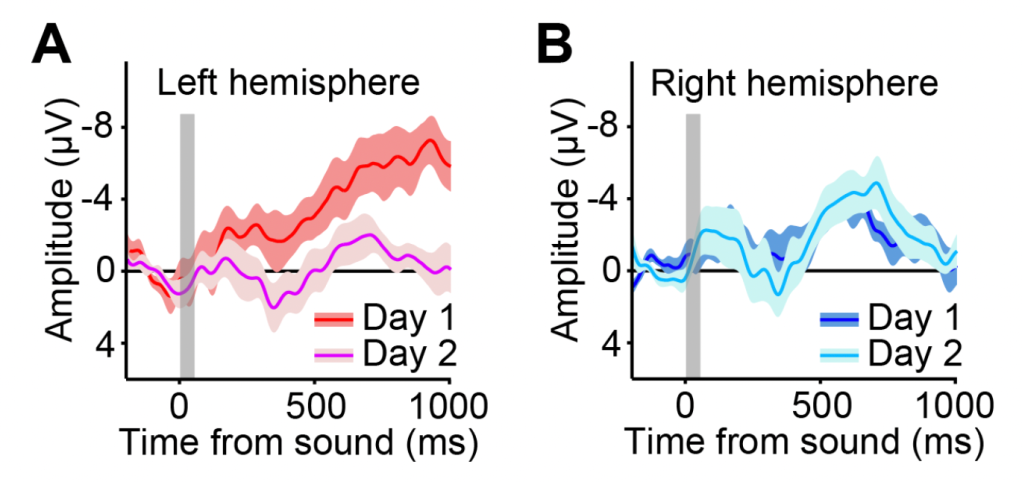Research topics
We are interested in how sleep influences our mind and behavior, and impacts various cognitive functions, such as learning, memory, and insight. We develop and integrate various neuroimaging (3T and 7T MRI), physiological (polysomnography, including EEG), and psychophysical methods to elucidate the fundamental role of the sleeping brain in human cognition.
How does sleep facilitate and stabilize learning?

After training on a new task, we become better at it after sleep, without any additional practice. We have investigated the neural mechanisms of this sleep-dependent facilitatory process in visual perceptual learning.
Visual perceptual learning is a long-lasting performance improvement on a visual feature after experiences. Getting better at finding pneumonia in x-ray pictures is an example of visual perceptual learning. How does such improvement occur? By utilizing neuroimaging methods, we have investigated the neural mechanisms of visual perceptual learning during sleep in humans.

We found that visual perceptual learning was associated with opponent but complementary neurochemical processing during nonrapid eye movement (NREM) and rapid eye movement (REM) sleep. NREM sleep facilitates offline gains, which is a significant improvement in performance by sleep, while REM sleep stabilizes learning such that learning will become more resilient to subsequent new learning.
We next investigated the neurochemical mechanisms of these two processes during sleep. We simultaneously used magnetic resonance spectroscopy (MRS) and polysomnography (PSG) in human subjects to measure the excitation/inhibition (E/I) balance during sleep. The E/I balance in the visual system was higher during NREM sleep compared to wakefulness. In contrast, during REM sleep, the visual system showed a lower E/I balance, or a hyper inhibitory state. The E/I balances during NREM and REM sleep correlated with offline gains and stabilization of learning, respectively.
These results revealed a possibility that increased plasticity during NREM sleep facilitates performance change, while REM sleep, which follows NREM sleep, serves to strengthen the neural changes that occurred during NREM sleep (complementary process hypothesis). We are currently investigating how sleep disturbances alter this plasticity – stability states in the visual cortex.


Related publications:
- Uji M & Tamaki M. Sleep, learning, and memory in human research using noninvasive neuroimaging techniques. Neurosci. Res. In press.
- Tamaki, M. & Sasaki, Y. Sleep-dependent facilitation of visual perceptual learning is consistent with a learning-dependent model. Journal of Neuroscience 42, 1777–1790 (2022).
- Tamaki, M. et al. Complementary contributions of non-REM and REM sleep to visual learning. Nat Neurosci 23, 1150–1156 (2020).
- Tamaki, M. et al. Reward does not facilitate visual perceptual learning until sleep occurs. Proc Natl Acad Sci USA 117, 959–968 (2020).

Half-awake state in a novel environment
When one sleeps in an unfamiliar environment, the experience is characterized by difficulty in falling asleep and reduced deep sleep. This temporary sleep problem is known as the first-night effect. By using multi-modal neuroimaging, we demonstrated that in the first-night effect, one brain hemisphere was partially more awake, more vigilant, and associated with faster behavioral response to rare auditory signals during deep sleep. This asymmetric sleep occurs regionally in the default-mode network. The default-mode network may play a role as a nightwatch so that a sleeper can react promptly to potential risks, similarly to unihemispheric sleep found in marine mammals and migrating birds.



Related publications:
- Tamaki, M., Bang, J. W., Watanabe, T. & Sasaki, Y. Night Watch in One Brain Hemisphere during Sleep Associated with the First-Night Effect in Humans. Current Biology 26, 1190–1194 (2016).
- Tamaki M, Sasaki Y. Surveillance during REM sleep for the first-night effect. Frontiers in Neuroscience.13:1161, 2019.
- TED-Ed “Can you be awake and asleep at the same time?”
Reading out visual contents of dreams
One of the most enigmatic aspects of sleep is dreaming. We have developed a novel ‘multiple-awakening method’ that allows us to collect as many dream-related brain data as possible. By combining functional magnetic resonance imaging (fMRI) decoding, a type of machine learning that is used for brain activation data, and this novel multiple-awakening method, we have succeeded in reading out the visual contents of dreams from brain activation patterns in human subjects for the first time. The results showed that visual perception during wakefulness and visual dreaming during sleep share common mechanisms in the visual areas, and in addition to that, we are now able to predict the visual contents of dreaming.
Related publications:
- Horikawa T, Tamaki M, Miyawaki Y, Kamitani Y. Neural decoding of visual imagery during sleep. Science, 340(6132), 639-642, 2013.
How do sleep disturbances influence brain plasticity?

While converging evidence suggests a good night’s sleep is critical for learning and memory, how such sleep disturbances impact the offline processing of learning has remained elusive. We are currently investigating how temporary and chronic sleep problems influence brain plasticity and learning.